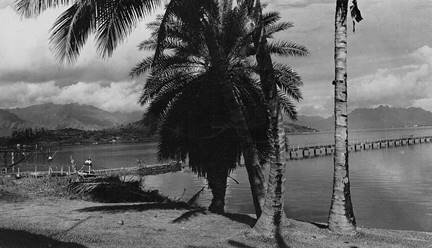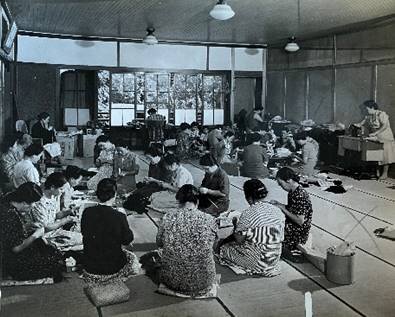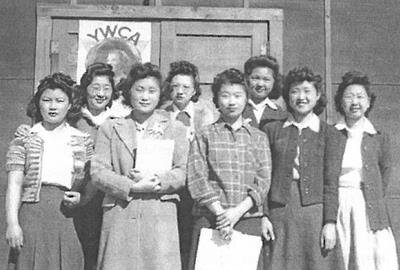A Moment in Our History: YWCA and Wartime
With its roots dating back to 1858 and the establishment of the first YWCA association in New York City, the national organization saw its role and community involvement adapt and change in times of war. During WWI, YWCA became the first organization to send professional workers overseas to provide administrative leadership and support to U.S. Armed Forces.
YWCA joined the United War Work Campaign and created the War Work Council. The aim of this campaign was to raise funds during the week of November 11-18, 1918 to “help boost American soldiers’ morale and provide them with recreational activities.” Seven voluntary organizations including YWCA and YMCA joined forces for this undertaking. Local associations like YWCA O'ahu contributed to this cause.
The goal was to raise “at least $170,500,000 in subscriptions and pledges” during that period in November, 1918
Mrs. Mary Dillingham Frear, then board president of YWCA O'ahu (1914-1919) called for 2,000 women and girls to “march under the Y.W.C.A. banner in the United War Work Campaign parade.” (The Honolulu Advertiser: November 8, 1918)
YWCA also participated in the Hostess Houses programs of the United Service Organizations Inc. (USO). During WWI, YWCA reportedly established 50 hostess houses at 37 military camps across the country and it employed more than 1,000 women as hostesses to maintain and keep the houses open 24 hours a day.
YWCA’s Hostesses Houses provided comfort to those who served in the military and their loved ones
The purpose of the houses was to tend to the needs of “the thousands of women who traveled, often long distances, to the camps in order to visit family members and “sweethearts” being trained there.” Those houses became shelters “in which the soldiers buffer the military and find personal comfort, and as places for women to gain experience in managing complex and relatively large institutions.” On O'ahu, Hostess Houses opened at Schofield and Fort Shafter.
“House for Colored Work” at Camp Dix in New Jersey. Black women joined war service organizations like YWCA and “established their own groups, to meet the specific needs of Black soldiers.”
WWII required local organizations like YWCA O'ahu to quickly shift to meet the demands of the time. The pace accelerated after the 1941 attack on Pearl Harbor. YWCA O'ahu served breakfast to the men of the new Hawaiian guard – starting with 60 a day and growing to 2,500 at its peak time. Both Camp Halekipa and Kokokahi were turned into rest camps by the military.
People lining up for the food service at Laniākea
Ms. Ginger Reeves wrote to YWCA O'ahu in 2009 to share a story about her father Mr. Richard Crick who spent time at Kokokahi after he was wounded on Iwo Jima shortly after witnessing the famous flag raising on Mt. Suribachi.
“My father said it was a green peaceful oasis and a much-needed place to help heal the hearts and minds of men who had been through the horrors of battle.”
Mr. Richard Crick stayed at Kokokahi to heal his wound and spirit during WWII.
Laniākea also became a site to support war efforts. The basement served as a shelter as needed. A surgical dressing unit of the Red Cross was established on the third floor. The unit first met in January 1942 and continued to function through the war – Monday through Friday between 9:00am and 12:00pm. The unit had a daily average of 70 volunteers producing 65,000 dressings a month.
YWCA Oahu’s International Institute mobilized volunteers to produce various needed articles. Across the country, YWCA’s national office offered services to Japanese American women and girls incarcerated in WWII Relocation Centers.
Local women participated in the works of the International Institute at YWCA O'ahu
Women and girls of Japanese ancestry benefitted from the work of the YWCA in many states across the country.
In 1943, Mrs. Eleanor Roosevelt visited Laniākea during her tour of the island to observe the works of the USO. She mentioned her visit at YWCA O'ahu in her national newspaper column as she described her trip to Hawai'i.
“… for a brief moment we stopped at the YWCA to see the girls who go out to dance and play and sing the soft Hawaiian songs for the boys in the late afternoons and evenings after their own day’s work is done.”
-Honolulu Star-Bulletin: September 28, 1943
Mrs. Roosevelt walking into Laniākea – pictured second from the left.
Roughly five months before the war ended, the ground floor and the lobby of Laniākea were transformed to the USO Services Women’s Lounge. The lounge included a library, an information desk and a writing area. On the opening day of the lounge, what caught the eyes of the service women was “the powder bar.”
“Cosmetics, supplied through the courtesy of Elizabeth Arden, range from the usual rouge and lipstick to skin lotions. Most of the girls were torn between dipping into the lavish display and not wanting to touch a thing, ‘it looks so lovely.’ Other features of the powder room bound to be a boon to service women are hot showers and ironing board and iron.” (Honolulu Star-Bulletin: April 21, 1945)
The ground floor and the lobby of YWCA O'ahu were occupied by the USO Services Women’s Lounge during WWII. The lounge opened on April 12, 1945.
With the end of the war YWCA O'ahu regained the operations of its facilities to continue its work aligned with the organization’s mission.
Lauhala weaving classes held in 1945 for nurses as part of the offerings by the USO Women’s Division Recreational Program in Honolulu. The instructor Mrs. Mabel Wood taught Lauhala weaving at YWCA O'ahu for more than 20 years























